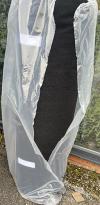The Ultimate Guide to Choosing the Best Walking Boots for Your Adventure | Contact Left Limited
he Ultimate Guide to Choosing the Best Walking Boots for Your Adventure | Contact Left Limited
One of the most common questions we receive at Contact Left Limited is: "What is the best walking boot?" Our answer? It’s the one that fits your feet perfectly! This may sound simple, but it’s true. Selecting the best walking footwear involves considering various factors that suit your unique needs.
Your choice of footwear can make or break any adventure—whether you're heading out on a local walk or tackling more rugged terrain. We believe that quality footwear should be your top priority, right alongside reliable waterproofs. That’s why we prefer to guide our customers in-store, offering personalized fittings and advice to ensure you leave with the perfect boot or shoe for your feet. After all, no two feet are the same!
To help you make the right decision, we’ve put together this comprehensive guide on what to look for when purchasing walking boots. We’ll walk you through the essential questions to ask yourself, key features to consider, and some handy tips to ensure your new boots are the perfect fit.
1. What Are You Using Your Walking Boots For?
Before choosing the right footwear, think carefully about what you'll be using them for. Don’t just say “walking”! Consider the type of terrain you’ll be hiking on. Are you tackling rough, mountainous paths, or will you be strolling along easier trails? Your choice of boot will depend on several factors, such as the level of support you need and the conditions you’ll face. Walking boots come in different heights, from low shoes to mid-rise boots and full ankle-high boots. Each design offers varying levels of ankle support, so it’s essential to choose a style based on where you’ll be walking and the support your feet require.
2. Waterproof or Not?
In the UK, waterproof footwear is often the go-to choice due to our unpredictable weather. Waterproof boots are fantastic for keeping your feet dry, but they can also be warmer than non-waterproof options. If you’re hiking in colder conditions, waterproof boots will keep your feet comfortable and dry. However, if you're planning to travel to warmer climates (whenever that might be!), you might want to consider breathable, non-waterproof footwear to avoid overheating.
3. Finding the Right Size for Your Walking Boots
When it comes to walking boots, sizing is crucial for comfort and performance. While you can use your regular shoe size as a guide, it’s common to size up by half or a full size for boots. This is particularly important because you’ll be wearing thicker socks, and your feet tend to swell as they warm up during activity.
How to Check Boot Size:
-
Insole Method: Remove the insole from the boot and place it on the floor. Stand on it, ensuring your heel is firmly in the insole’s heel cup. There should be enough space at the top of the toes to fit a finger width. If you can’t fit a finger, the boots are too small.
-
Footwear Fit Test: Put on the boots and push your feet to the front. With the laces not tied, try to fit a finger between your heel and the back of the boot. If you can’t fit a finger, the boot is too small. If there’s more than one finger's width, the boot is too large.
4. How to Lace Your Walking Boots for a Perfect Fit
Once you've found the right size, it’s time to lace your boots properly. Lacing isn’t as straightforward as it seems, but it’s essential for the best fit and performance.
Start by ensuring your heel is comfortably settled into the heel cup of the boot. Gently push your ankle back into the boot, and then lace the boots from the toes upward. You should be able to slide just the tip of your fingers under the laces for a snug, supportive fit. Proper lacing ensures that your foot stays securely in place, offering maximum support and reducing the risk of blisters or discomfort.
5. What to Look for When Walking in Your Boots
After lacing up, take a moment to walk around in your new boots. Here’s what you should be looking for:
- Toe Room: Make sure there’s enough space in the toe box. Your toes shouldn’t feel cramped or pressed against the front of the boot.
- Flexibility: Check for excessive flex or creasing in the boot when walking. A small amount of flex is normal, but if the boot feels overly flexible, it may not provide the support you need.
- Comfort: Ensure that there is no pressure on your toes or the top of your foot. You should feel supported but not restricted.
If your boots feel too tight or too loose in any of these areas, you may need to look for a different model or style. Boots that don’t fit properly can cause premature wear, leading to cracks or discomfort.
Why Getting the Right Fit Matters
Investing in the right walking boots is not only about comfort—it’s also about durability. Well-fitting boots will last longer, perform better, and reduce the risk of injury. Whether you’re preparing for a challenging hike on rugged terrain or just a relaxing stroll, the right boots will make your adventure more enjoyable and pain-free.
At Contact Left Limited, we understand the importance of proper footwear, and we’re here to help you find the perfect pair of walking boots. Visit us today for personalized advice, expert fittings, and a wide selection of walking boots and outdoor gear.
By focusing on the right fit, material choices, and intended use, you’ll ensure your walking boots will support you on every journey. Whether you’re an avid hiker or just enjoy outdoor activities, taking the time to choose the boots that best suit your needs is key. Ready to find your perfect pair? Explore our full range of walking boots and gear at www.contactleft.co.uk












